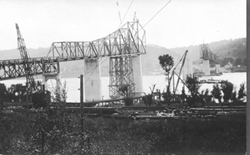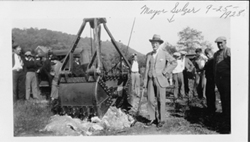



Relics of the past
Milton-Madison
Bridge project to save,
restore historic 1929 film
Superstructure replacement slated to begin in fall
By
Konnie McCollum
Staff Writer
(April 2010) – A government project involving
potentially explosive film carefully transported to a special lab in
Maryland doesn’t sound like something involving the Milton-Madison
Bridge Replacement Project. But it is.
 |
|
Photo
courtesy of Heritage Research Library of Jefferson County This
1929 photo shows the |
Although the reality is not as mysterious as it sounds,
the 20-minute film involved is an important part of the historic legacy
of the 80-year-old Milton-Madison Bridge. The bridge is scheduled to
be rehabilitated with a new steel superstructure by 2012.
On Dec. 20, 1929, despite bitter cold weather, dignitaries, townsfolk
and even the governors of Kentucky and Indiana gathered for a grand
ceremony to open the new Milton-Madison Bridge.
Festivities included the crowning of a queen, a parade through downtown
Madison, Ind., and speeches by local and state leaders. Madison-based
Lorenz Film Productions recorded the christening ceremony for future
generations.
As a stipulation of the Memorandum of Agreement in the current project’s
National Environmental Policy Act document, the original 1929 film is
to be restored, and copies in a stable film medium will be produced
and distributed to various local, state and federal agencies. The cost
of the process is expected to be about $5,100, although officials said
the final cost depends on the condition of the film once it is inspected
by experts.
“I have been involved with transportation projects for almost 40
years,” said John Carr, project manager for lead consultant Wilbur
Smith Associates. “This is a first. Converting the original 1929
film of the bridge opening ceremony preserves part of Madison’s
and Milton’s history that could be lost forever. I think that all
of us on the project team saw this as a ‘win-win’ for the
project and communities. We were proud to make this happen.”
Historic Madison Inc. acquired the original 35mm film in 1993 from the
Lorenz family. It has been kept in safe storage since then.
“We knew it was costly to process and preserve the piece, but we
didn’t have the funds” said John Staicer, executive director
of HMI. “I mentioned the film as a potential item for the MOA during
a Section 106 meeting last fall. We are thrilled the project is going
to restore this important piece of our community’s history.”
The process is expected to take approximately six weeks to complete,
and when the film arrives back in Madison, a community screening at
a local theater is being planned for later in the year, said Staicer.
Like most films of its era, the opening ceremony film was made using
a material called cellulose nitrate, which was transparent, light, flexible
and easy to handle. Unfortunately, however, unless stored at a very
low temperature, cellulose nitrate motion picture and still photographic
film self-destructs at an unpredictable rate over time. Deteriorated
nitrate film is highly flammable and can even burn under water; once
ignited, nitrate fires are almost impossible to put out. Most photographers
and filmmakers of the early 20th century had no knowledge of the volatility
and problems with nitrate film.
Staicer hand delivered the film to A Package Deal, a custom crate and
box company ,in Louisville, Ky. The firm is one of a handful of companies
in the region certified to package hazardous materials.
 |
|
Photo
courtesy of Heritage Research Library of Jefferson County Then-Madison
Mayor Sulzer |
“We packed the film in cold packs and Styrofoam,”
said company representative Shirley Champion. “As long as the film
is kept cool, it is fine.” Her company has a special hazmat account
with Federal Express, which shipped the package to ColorLab in Rockville,
Md.
In the early 1970s, ColorLab was started primarily as a motion picture
laboratory doing film to tape transfers. Through the years, its expertise
and reputation grew. The lab now works with the National Archives, the
Library of Congress, the Holocaust Museum, and many state historical
societies on film preservation and duplication.
“We just received the Milton-Madison Bridge film,” said ColorLab’s
Kevin Fallis. “There are several stages in the process of conserving
and reproducing this type of film, but we first have to evaluate it
to get a better idea of its physical condition.”
At some point, the film’s images will be transferred from the fragile
original base and transferred to a film base that will last. A telecine
machine is used to scan and record the images onto contemporary material,
said Fallis. “The original will then be packed and sent to HMI,
where it should be put into cold storage.”
As part of the MOA, the original film will be preserved and a high quality
master negative film will be created. The master negative will be given
to HMI. Twenty-four DVD copies of the film will also be created and
distributed to HMI, the state libraries in Indiana and Kentucky, local
public libraries in Madison and Bedford, Ky., the Indiana and Kentucky
State Historic Preservation Offices, the City of Madison, City of Milton,
Jefferson County Historical Society, Trimble County Historical Society,
Kentucky Transportation Cabinet, Indiana Department of Transportation,
the Federal Highway Administration and other local and state agencies.
In other Milton-Madison Bridge news, the KYTC and INDOT announced federal
environmental approval of the NEPA document, which will allow the states
to move toward the design and construction phase of the project.
Once a funding agreement is reached, INDOT will advertise a construction
contract for a period of 11-12 weeks, during which time bids will be
accepted through a competitive letting process.
The contract is expected to be awarded in late summer with construction
efforts beginning this fall. Construction should take approximately
24 months with the bridge expected to close to traffic in early fall
2011. Contractors will be permitted to close the bridge for a maximum
of 12 months, and a free ferry service across the Ohio River will be
offered.
• For more information on the project, visit: www.MadisonMiltonBridge.com.